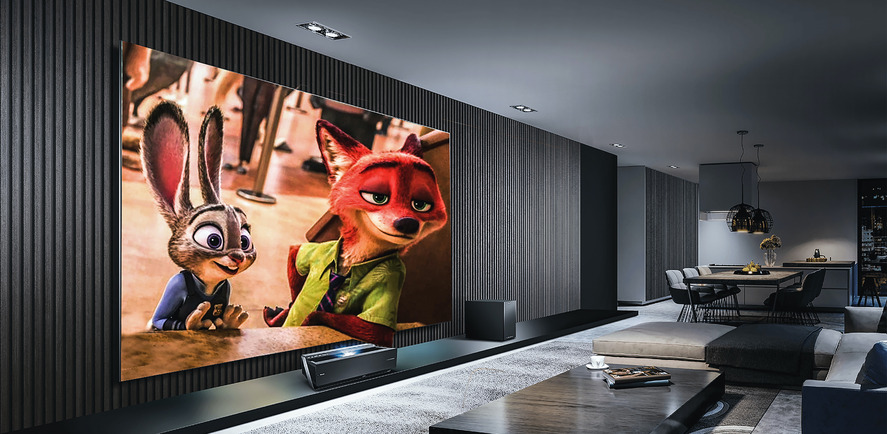Streaming relatively new movies in comfort with extra entertainment is all about home theater. Instead of a big-screen experience at a cinema, you can have all that high-quality video experience and immersive audio exposure at home but you need a little guidance on that.
Every component discussed below is available online but you need to consider those companies that have positive reviews. For reading reviews, consider Collected.Reviews as this is a reviewing community that discusses experiences and feedback in the form of reviews and helps people to make decisions based on customer reviews.
What’s in this guide?
There are a lot of connectivity options for home theaters out there that you can try and it can become an investment in happiness. In this guide, we’re going to explain the required home theater equipment a beginner may consider. Moreover, budget is the main concern which we’re going to cover in this start-to-finish guide. Well, screen, projector, speaker, and control system are four of the major players in the home theater game and curtains and concession stands are the pluses if you have.
We’re going to discuss everything in these 4 steps …
Step 1: Analyze your space
Step 2: Choose a theme
Step 3: Pick the equipment
Step 4: Implement the plan
TV or projectors create a real experience when watching any movie or a show but the sound system should also be of great quality as the real home theater experience relies on it.
STEP 1: ANALYZE YOUR SPACE
Before analyzing your space, you must consider dedicating a room to the screen. A dedicated home theater room is only for watching movies on a large screen. This suggests that there isn't much else going on in the home theater but screenings with streaming services like Amazon Prime, Netflix, Hulu, BluRay movie, or any other medium. The cinematic experience is curtailed when the home theater holds air with other activities.
People frequently run the risk of selecting their theater screen before considering which dimension and layout would be the greatest match for the room. Consider hiring the contractor who will develop engineering models for the space that contain the room's height, breadth, and depth, as well as the position of windows and doors. These layouts are used to determine how many seats can be comfortably accommodated in the room, the appropriate distance between seats and the screen, speaker placement, and so on.
STEP 2: CHOOSE A THEME
Some of the world's top home theaters feature distinctive themes based on movies, novels, locales, and other media. Pick something meaningful to you and integrate it into every facet of the area, from the wall sconces to the ceiling color, if you want to steampunk aesthetic your home theater.
The theme will influence the sort of seating you choose, the décor, the lighting, and even the A/V equipment, so think about what you want for the room before you start choosing out your screen or theater curtains.
STEP 3: PICK THE ESSENTIALS
Due to all the choices and technical jargon, it becomes frustrating to narrow down the choices. In this step, we’ll be discussing each essential factor to consider to buy one.
Screen - Attractive Centerpiece for Home theater
Size? Screen gain? 4K resolution screen? Different colors? For the best possible picture, these screens are optically coated. You need to consider pixel geometry here because a slight texture, little gradients, or lack of flatness can disturb the streaming experience. Sharpness and clarity matter a lot. Moreover, color accuracy and smooth image are a must.
There are different types of projector screens including 4K projector screen, 8K projector screen, 16K projector screen, and UST projector screen are the recommendations for the screen.
Projector - Bigger Image than TV
To buy a home theater projector, many factors are worth mentioning but are impossible to discuss here. Some of them are; Lumens - The first and foremost thing to consider is Lumens (brightness measuring) which depends upon the viewing environment. Dedicated home theaters need 1000 lumens or more.
Image Quality - The second factor to consider is image quality which is followed by the resolution, source material, and contrast ratio. Most commonly, HD (1920 x 1080) are the resolutions that people notice because of more pixels which give sharper images. Native aspect ratio - The third factor to consider is the native aspect ratio which varies under 4:3, 16:10, and 16:9 proportions. A 16:9 native aspect ratio is designed primarily for home theater use because widescreen DVD, Blu-ray, and HDTV signals are broadcast or encoded in the 16:9 format.
Lamp life - The fourth factor to consider is lamp life which refers to the half-life of the lamp after which the screen lights start becoming low making the picture fade away. The average lamp life of the LCD and DLP projectors is 2000 - 4000 hours.
After selecting a home theater projector, the problem is to install the projector. You have two options; Ceiling mounting or tabletop projection. Ceiling Mounting is a smart option as it will save your time in setting up the projector for each use. Also, your projector will be secure there. Moreover, the throw ratio is the distance between the projector and screen which must be fixed. It depends upon your room whether to keep the distance of 5 feet or 10 feet.
Speakers - Immersive Audio Experience making multi-channel home theater
Don’t worry! You don’t have to be an audiophile to install an amazing audio system. For a complete surround sound system, you should have a 5.1 speaker system. “5” means speakers in the front left, front right, center speaker, surround left, surround right, and “1” means subwoofer. The subwoofer delivers smoother sound bass by fleshing out low-end effects. You can also consider the 7.1 speaker system which comes with two extra speakers to give an immersive audio experience.
Home theater speakers
come in all sizes from the bookshelf to floor standing speakers. The flexibility in choosing depends upon the space you have. Well, this gives you a multi-channel home theatre experience.
Receiver - Multi-channel Amplifier
To power your whole theatre sound, you need a home theater receiver. Its job is to receive, interpret, and send audio signals to the destination (speaker). With a 7.1 speaker system, you will not need it but for a 5.1 speaker system, you may need one. With home theatre speakers, this boosts the experience of the sound system.
Power Manager - Regulates Power Distribution
Noise filtration, power regulation, and surge protection - all these three roles are being played by a home theatre power manager. Most people think they don't do it until they experience dirty power, lightning surges, and power outages. You must buy one as they regulate power distribution to the electronics and devices. Moreover, they feature sequential system power and over/under voltage protection.
There are several factors that you must look into; including size, protection against power outages, power adapter, availability of outlets, clamping voltage, and energy absorption rate. Last but not the least, and somehow an important factor is a budget.
Curtains - Reduce Reverberation and Noise
You can’t deny the importance of adding curtains to the home theater buying list. The blackout curtains play an important role in reducing the light filtering into your TV as well as improving the acoustics by reducing the echo and noise. Energy efficiency and ambiance are other benefits of home theater curtains.
There are several factors that you must look into; including; dimensions, material, insulation, color, texture, mounting style, fabric weight, and thickness. To enjoy the deep blacks on your screen, you must narrow down your choices based on these aspects.
Concession Stands - Snack Stand You Can’t Resist
Home theater concession stands should be grab-n-go setups. Whenever you’re building a concession stand at your home, you must include the best equipment that you can enjoy with your movie. Classics, sweet treats, salties, thirst quenchers, healthy snacks, and no prep goodies are the most common selections to meet your cravings.
Classic concessions - hot dogs, wings, french fries, popcorns
Sweet treats - cupcakes, sugar cookies, cake pops, muffins
Salty snacks - potato chips, mozzarella sticks, bagel bites, hush puppies
Thirst quenchers - coffee, smoothie, soda, milk, juice boxes, lemonade
Healthy snacks - homemade granola bars, sliced apples, sweet potato chips, frozen popsicles with fruit
No prep goodies - dried fruits, cheese sticks, cereals, fruit snacks
For all the above-mentioned essentials for home theater, you must read the online shopping reviews to support your buying decisions.
STEP 4: IMPLEMENT THE PLAN
After you've decided on all of your strategies and materials, it's time to put them into action. This step may not take long at all, depending on the existing state of the space and the scale of your theatre’s ambitions. Still, some things should be considered here. Hide your media - To keep the design clean and clutter-free, tuck all the equipment and cords away.
Design integrated cabinetry - House the equipment and conceal speakers within the walls and ceilings, as well as behind the cinema screen, without sacrificing sound experience.
Networking needs - 4K UHD streaming consumes a lot of bandwidth, you'll need to configure your network to handle the extra stress.
Everything you need for a reliable, high-end home theater!






